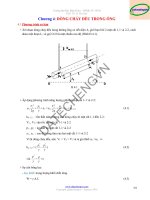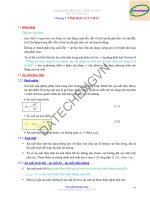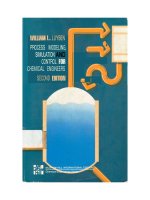Giáo trình bài tập chapter5
Bạn đang xem bản rút gọn của tài liệu. Xem và tải ngay bản đầy đủ của tài liệu tại đây (1.12 MB, 75 trang )
CHAPTER 06
THE SUBSURFACE
ENVIRONMENT
UA-2011
1- GROUND WATER AND
TEMPERATURE
1.1 ᾶ GROUND WATER
1.2 ᾶ TEMPERATURE
2- PRESSURE AND DYNAMICS
2.1 – PRESSURE
2.2 – DYNAMICS
1- GROUND WATER AND
TEMPERATURE
1.1 ᾶ GROUND WATER
1.1.1 ᾶ Origin of ground water
1.1.2 ᾶ Chemistry of ground water
1.2 ᾶ TEMPERATURE
1.2.1 ᾶ Subsurface Temperature
1.2.2 ᾶ Regional thermal Variations
1.2.3 ᾶ Local thermal Variations
1.1- GROUND WATER
1.1 .1 ᾶ Origin of ground water (GW)
04 types of GW
1. Meteoric water.
2. Connate water.
3. Juvenile water.
4. Mixed water.
04 Types of GW
Meteoric water
Infiltration of rainwater.
Distribution @ shallow depth.
Total mineralization: Low
Tens to be Oxidizing
pH: Often acidic due to dissolved humic,
carbonic and nitrous acids.
Connate water
Ancient sea water which was trap in the
sediment during burial.
Differs
from
seawater
both
in
concentration of dissolved salt and pH,
04 Types of GW (cont.)
Juvenile water
Primary of magmatic origin.
Brought to near ᾶ surface environment
dissolved in magma.
Usually mixed with either connate or
meteoric water.
Mixed water
Results from the commingling of
meteoric, juvenile and connate waters.
Usually between the near – surface meteoric
water, juvenile and the deeper, more saline
connate water.
1.1 .2 ᾶ Chemistry of ground water
Connate water, meteoric water and
mixed water can be differentiated on the
basics of their chemistry.
Way can be done:
First:
Eh: Oxidation/reduction potential
and
pH: Measure of acidity or alkalinity
of the water
Eh >0: Considered to be oxidizing
<0: Considered to reducing
+
pH = 7: [H
]= [OH ] Considered to be
neutral
<7: Acidic
Fig 01
Deep connate water show a wide range of
Eh and pH depending on their history and
how much theyᾼve mixed with meteoric
water.
Oilfield brines
tends to be more alkaline
and more strongly reducing than seawater.
The Eh and pH of pore fluids control the
precipitation and dissolution of cements
such as the carbonates and ion oxides, as
well as the alterations of clays minerals in
subsurface rocks Extremely important to
understand the relationships of Eh and pH
to diagenesis and the evolution of porosity.
Chemistry of ground water
(cont.)
Second: Salinity
In general salinity
of GW increases with
depth ( normal hydrochemical profile
)Fig.02. The rate of increases varies from
basin to basin, even from place to place
within a particular basin.
Typical seawater has a salinity of about
35ppthousand (3.5%).
The salinity of GW range from near zero (in
newly
introduced
meteoric
to
>
600ppthousand (60%) in connate water
within evaporate formation.
Fig 02
Reversal hydrochemical profile
have
been observed due to two possible causes:
1. Meteoric can be trapped beneath an
unconformity
and
preserved
as
᾿Paleoaquifer῀ with relative low salinity as
compared connate water above the
unconformity.
2. Overpressure: In shale sequences,
formation water is trapped.
In shale, the increases in salinity with depth
is less noticeable than in sandstones:
Water moves upwards in compacting
sediments, shale acts at semipermeable
membranes preventing salt escaping from
Four major sub. environment:
1. Zone 1 (surface → 1km) uniform Zone of
circulating meteoric water. Salinity fairly uniform;
2. Zone 2 (1 → 3km) gradually increases with depth
Saline formation water is ionized;
3. Zone 3 (3km) Chemically reducing
environment, in which hydrocarbons form. Salinity
uniform with increasing depth; may even decline
if overpressured;
4. Zone 4 incipient metamorphism with
recrystallization of clays to micas.
Formation water
classification
Oder
Category
Total dissolved Solids
g/l
%
< 0.2
0.02
1
Super fresh
2
Fresh
0.2 – 1.0
0.02 – 0.1
3
Brakish water
1.0 – 3.0
0.1 – 0.3
4
Light saline
3.0 – 10
0.3 – 1.0
5
Saline
10 – 35
1.0 – 3.5
6
Brine
> 35
> 3.5
Table 01
Klimentov, 1977
Oder
Category
1
Fresh
2
3
Brakish
water
Saline
4
Brine
Total dissolved
Solids
<(mg/l)
1,000
1,000 – 10,000
10,000 – 100,000
> 100,000
Freeze and Cherry, 1979
Table 02
ê
Regional isosalinity maps are very useful
exploration tools.
Area of high salinity
possible indicate
stagnant regional are uneffected by
meteoric flushing ( where oil/gas
accumulation may be preserved
)
GW Composition
ê
ê
Meteoric water differs from connate
water both salinity and proportions of
dissolved irons.
Meteoric water divided to:
2+
+ High proportions of SO
4 and Na .
+ High CO 2- 3 and Na + .
Connate water divided
to:
ê
ê
+ High proportions of CL
and Mg 2+ .
2+
+ High CL
and Ca
.
In comparison to seawater, connate
water high concentration of soluble
chlorine and sodium. (Tab 03)
(Br is more abundant than seawater)
SO2- 4 in connate water << seawater:
+ Precipitation of CaSO 4
+ SO 2- 4 reduction by bacterial action,
producing H 2 S gas.
Table 03
ê
ê
2+
Depletion of Mg
in connate water
due to dolomitize .
2+
Ca
in connate water > in
seawater:
+
Release
of
calcium
from
dolomitize.
+ Dissolution of SO 2- 4 .
+ Release of calcium during clay
+ →
diagenesis (montmorillonite + K
2+
2+
illite + Ca + Na + H2O).
+ Low rate of calcium precipitation.
• Depletion of potassium probably results from
the uptake of that element by clay minerals.
• Connate waters also contain traces of
dissolved hydrocarbons which are not
common in normal sea water (Buckley et al.,
1958).
– This is significant for two reasons: First, it raises
the possibility of regionally mapping dissolved
hydrocarbons as a key to locating new oil and gas
fields. Second, it has some bearing on the
migration of both oil and gas.
GW research application in O&G Exploitation &
Exploration
(By Tran van Xuan)
GW research application in O&G Exploitation &
Exploration (Cont.)
• + Sulin classification : Water is divided based
on Ion ratio, which specifying different
generation conditions, and especially in oil
and gas formation water. This classification
is widely applied in petroleum hydrogeology
+ , rCl - Ὴ are
• Based on relationships (rNa
caculated by %mol/l):
rNa
rCl
rNa rCl
rSO4 2
rCl rNa
rMg 2
FW divided to 4 types (by Sulin):
1. Sodium sulfate (cratonic solution origin):
rNa
rCl
>1;
rNa rCl
rSO4 2
< 1 and
rCl rNa
rMg 2
<0
2. Sodium bicarbonate (cratonic origin):
rNa
rCl
>1;
rNa rCl
rSO4 2
> 1 and
rCl rNa
rMg 2
<0









